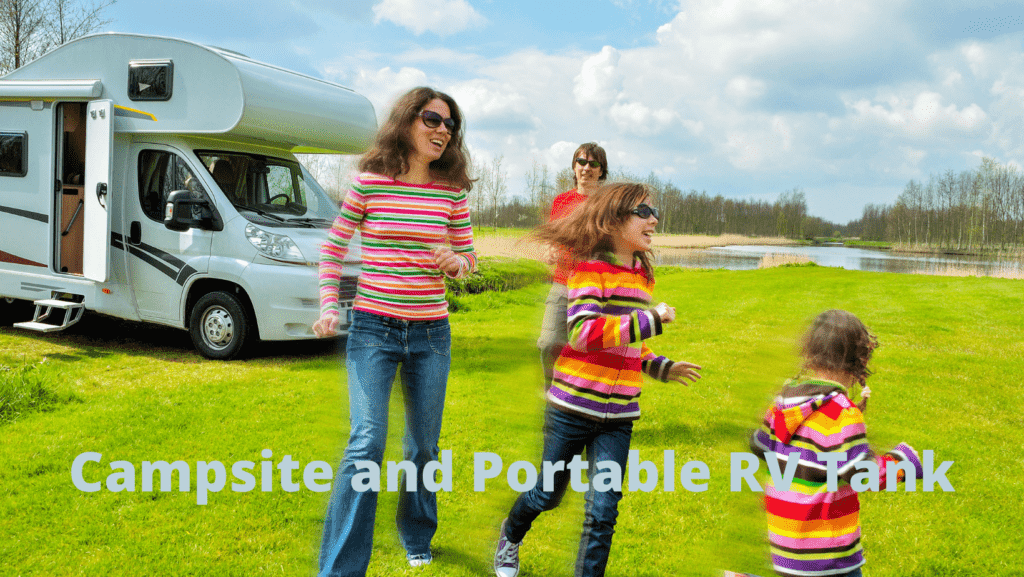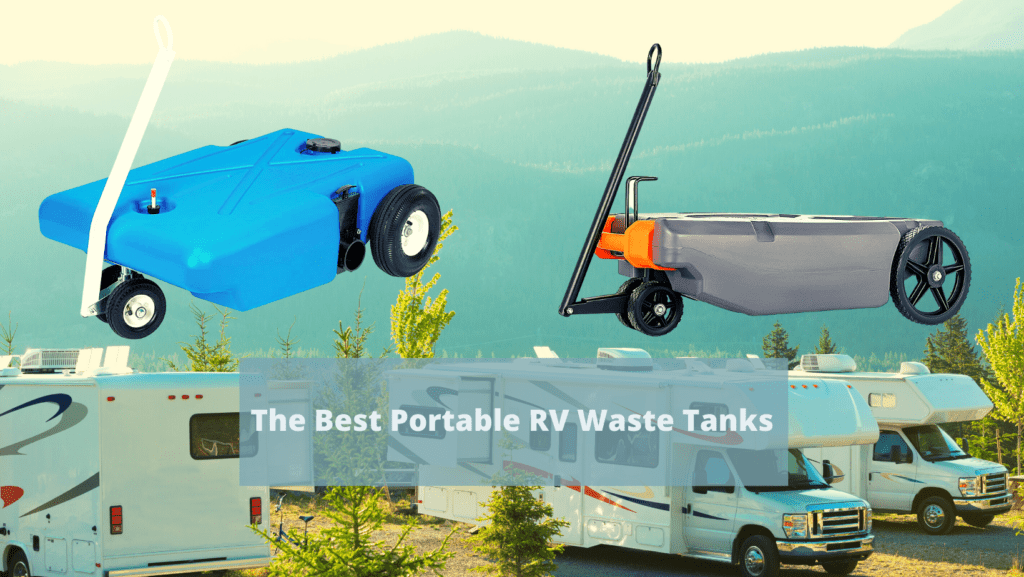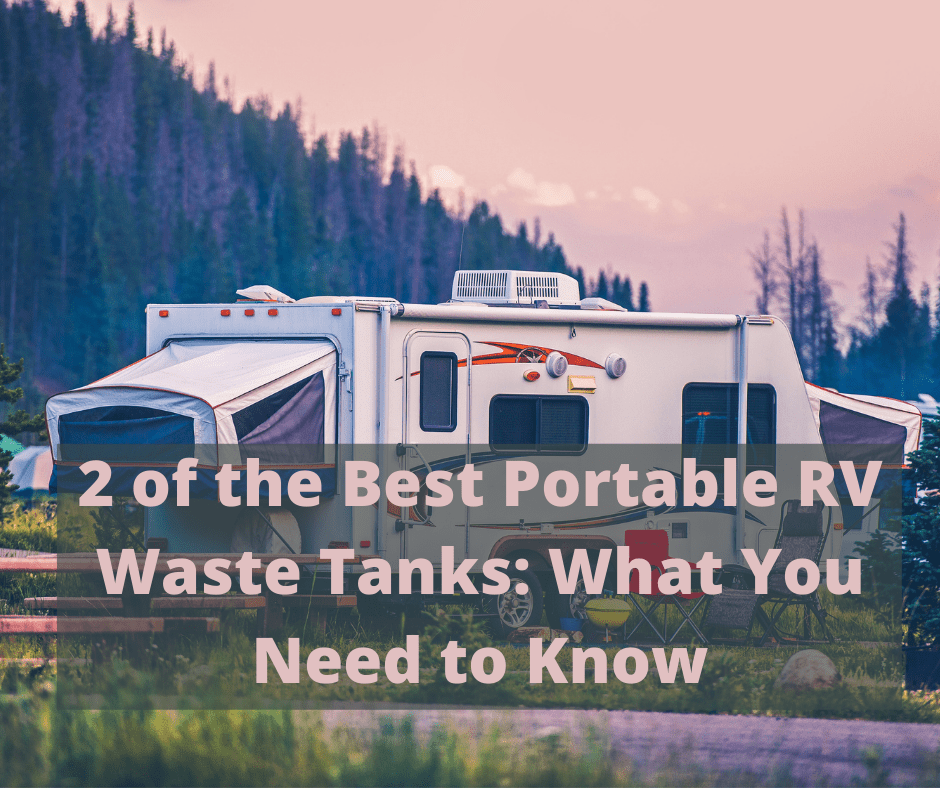Traveling and exploring the country in an RV is a great adventure, but what do you do when the campground doesn’t have a sewer hookup? Using a dump station is one solution, but it can be inconvenient if there are long lines or if you have to search for one. A better option is to use a portable RV waste tank or a waste tank for Pop Up Campers. This blog post will discuss two top portable RV waste tanks and offer important information to keep in mind before buying one.
Pop Up Camper & RV Portable Waste Tank
RVs are a great way to explore the country and see new places, but they can also be a hassle to keep clean. One of the most difficult aspects of RV maintenance is dealing with the sewer tank. Portable RV sewer tanks can help make this task easier.
These tanks are designed to be easily transported and emptied, and they come in a variety of sizes to suit different RVs. Most importantly, they can help to prevent messy and smelly spills, making it easier to keep your RV clean. Whether you’re a full-time RVer or just going on a weekend getaway, a portable RV sewer tank can be a valuable addition to your rig.
Campsite and Portable RV Tank
If you do a lot of camping, you may find yourself staying in one place for an extended period of time. This can be problematic if your campsite doesn’t have a sewer connection.

A portable holding tank can be a solution to this problem. It allows you to dump your camper waste tanks without moving your entire travel trailer or motorhome. Choosing the right one for your setup can be confusing, but this guide will help you make the right choice. Additionally, you’ll learn how to use it properly so that you can avoid any problems.
What to Consider When Choosing a Portable RV Waste Tank
When choosing a portable RV waste tank, there are several factors that you need to take into account. The first is the size of the tank. You need to make sure that it’s big enough to hold all of your camper’s waste. If you have a large camper, you may need to get two tanks.
Another factor to consider is the material that the tank is made out of. Most portable RV waste tanks are made out of plastic, but there are also some that are made out of metal. Plastic tanks are usually lighter and more affordable, but they can be prone to leaks. Metal tanks are more durable, but they’re also more expensive.
You also need to consider the type of valve that the tank has. Some tanks have a gravity flush valve, which is simple to use but can be slow. Other tanks have a macerator pump, which is more expensive but much faster.
Finally, you need to decide how you want to empty the tank. Some tanks have a hose that you can connect to a sewer connection. Others have a pump that you can use to empty the tank into a holding tank.
The Best Portable RV Waste Tanks
Now that you know what to look for in a portable RV waste tank, it’s time to take a look at some of the best options on the market. Our view on the best portable waste tanks will change as new and more advanced gray water tank models are released in 2023. This way you can be sure that you look at the latest portable waste water tanks that you can use with your campground dump station even if you have an onboard tank.
[affiliatable id=’95269′]The first option is the Camco Rhino RV Heavy Duty 28 Gallon Portable Waste Holding Tank with Steerable Wheels. This tank is made out of durable plastic and has a capacity of 28 gallons. It comes with a gravity flush valve, so it’s easy to use. Additionally, it has a super heavy-duty sewer hose that you can use to connect to a sewer connection.
The second option is the Barker 4-Wheeler Tote Tank. This tank is made out of durable plastic and has a capacity of 25 Gallon Capacity (models with 42 Gallon Capacity and 32 Gallon Capacity are available). It comes equipped with a grade, 3-inch traditional waste valve for ease of use and reliable commission. No need to lift up your tote tank to drain it, simply open the 3″ waste valve.
Both of these options are great choices for a portable RV waste tank. They’re made out of durable materials and have a capacity of 28 gallons or more. Additionally, they come with a hose so that you can easily connect them to a sewer connection.
How to Use a Portable RV Waste Tank
Now that you know what to look for in a portable RV waste tank and have two great options to choose from, it’s time to learn how to use one.
Using a portable RV waste tank is simple. First, you need to connect the tank to your camper’s waste holding tanks. Next, you need to open the valves on both the tank and your camper’s holding tanks. Then, you need to turn on the pump or gravity flush valve. Finally, you need to empty the contents of the tank into a holding tank or sewer connection.

Once you’re finished using the portable RV waste tank, you need to disconnect it from your camper and close all of the valves. Then, you need to rinse out the tank with clean water. Finally, you need to store it in a safe place.
By following these steps, you’ll be able to easily use a portable RV waste tank. Additionally, you’ll be able to avoid any problems that might occur.
Are Portable Tank Necessary?
Portable RV dump tanks can be a convenient tool for some RVers, particularly those who boondock without utility connections. These tanks provide an easy way to dispose of grey and black water, and they can help to extend the time between dumping sessions.
However, they are not necessary for every RVer. Those with smaller rigs or who are conscious of their water usage may find that they can do without a portable dump tank. Ultimately, the decision of whether or not to use one of these tanks is up to the individual RVer.
Having a portable tote tank for your recreational vehicle can be a great idea in some situations and not so great in others. Here are some scenarios to consider:
- If you like to dry camp or boondock often, then an auxiliary tank can give you the extra water you need without having to worry about running out. This is especially true if you have a larger RV; the additional water capacity can be very helpful.
- On the other hand, if you mostly camp in developed campgrounds with hookups, then an auxiliary tank may not be necessary. You can just hook up to the water spigot and fill up your freshwater tank as needed. And if you do happen to run low on water, most campgrounds have a dump station where you can fill up for free.
If you want to stay on public lands for an extended period of time, it’s important to have a portable RV septic tank. These tanks are designed to hold wastewater until it can be properly disposed of, and they’re big enough to accommodate even the longest camping trips.
For anyone who loves spending time outdoors, a camper is a great way to explore the world while still having home comforts. However, one of the less glamorous aspects of owning a camper is dealing with the wastewater. If you routinely stay at campgrounds that require you to haul your camper to one of the dump stations, a tote tank makes sense.
Especially if you usually stay for more days than your tanks can last before filling up. A tote tank is a portable tank that can be easily towed behind your camper. It is great for short trips or for extended stays at campgrounds that do not have easy access to dump stations. Plus, it means that you do not have to worry about your tanks overflowing while you are away from home.
Portable Dump Tanks Not Necessary
As any seasoned camper knows, there are many different types of camping, and each one has its own unique set of challenges. One type of camping that is becoming increasingly popular is RV camping.
RV campers have the luxury of being able to bring all the comforts of home with them on the road, but they also need to be mindful of their waste tanks. If you are a camper who likes to stay at full hookup campsites, you don’t need a portable waste water tank.
This is because you can empty your RV tanks without moving. However, if you are a camper who moves around a lot, you may want to consider investing in a portable waste water tank. This is because you may not always be able to find a full hookup campsite.
Additionally, if you have a small camper where the storage room is at a premium, a portable waste water tank can be a worthwhile investment. This is because it can help you save space in your camper.
So it really depends on your individual camping style as to whether or not an auxiliary tank makes sense for you. But if you do a lot of dry camping, then it’s definitely something to consider.

Characteristics To Look For In An RV Tote Tank
Storage Capacity
When shopping for an RV tote tank, the first consideration should be storage capacity. How many gallons of wastewater can the tank hold? You want a tank that is large enough to minimize trips to the dump station, but small and light enough to handle and store easily.
Durability, Easy Dumping, and A Built-In Discharge
Other features to look for include durability, easy dumping, and a built-in discharge hose. Durability is important because you don’t want your tank to crack or leak, and easy dumping is self-explanatory. A built-in discharge hose is a nice feature to have because it eliminates the need for a separate hose and makes emptying the tank more convenient.
2 or 4 Wheels
When deciding on a portable RV dump tank, one of the key considerations is the number of wheels. Most tanks have two rubber wheels in the rear, which provide good stability and can easily be towed behind an RV.
However, some models also have two smaller front wheels, which can be useful for steering the tank into tight spaces. The front-mounted double wheel assembly is also typically on a swivel assembly, making it even easier to maneuver. Ultimately, the decision of whether to choose a two- or four-wheel model depends on personal preference and how the tank will be used.
By considering these factors, you can be sure to find the RV tote tank that best meets your needs.
Wheel Construction
When it comes to wheel construction, there are a few things to take into consideration. For starters, are the wheels made of cheap plastic or better quality rubber? Rubber wheels are typically more durable and can handle uneven terrain better than plastic wheels.
Additionally, rubber tires are often quieter than plastic ones. Another thing to consider is the width of the tires. Skinny tires may be fine on hard surfaces, but they can sink into loose dirt or gravel. Wider tires are a better option for off-road use or any time you might encounter uneven ground.
Finally, some wheels have a hybrid design with a plastic center and rubber treads. This type of wheel offers the best of both worlds in terms of durability and performance.
Grab-Handle
The grab handle on a two-wheeled RV holding tank is essential for moving it around when it’s full. This handle should feel good to your hands and be easy to grip. A four-wheeled tote may not have this handle, but it’s not essential to maneuver it around.
The grab handle makes it easier to lift and move a full RV holding tank. It’s also helpful when emptying the tank into a dumpster or other container. The grab handle is an essential feature on a two-wheeled RV holding tank.
Tow Bracket
A tow bracket is a handy tool that can make it much easier to move a portable RV black water tank. Most tow brackets are made of zinc-plated steel and have a tow adapter that connects to the handle of the tank.
This allows you to tow the tank behind a vehicle, making it much easier to transport. Some tow brackets also have wheels, which can make it even easier to move the tank around on the ground. When choosing a tow bracket, make sure to consider the size of your tank and the type of terrain you’ll be using it on. With a little bit of research, you can find the perfect Tow Bracket for your needs.
Ways To Drain The Tank
One of the most important aspects of owning an RV is properly maintaining the sewage tank. All portable sewage tanks have a 3-inch standard-sized drain hole on the top, which is used to fill the tank with the RV’s wastewater. In some cases, this is also how you empty the tank – by lifting the front vertically so that the waste will drain out of this top opening.
However, this can be difficult and unpleasant, as you arelifting a container full of sewage. Fortunately, some tanks come with a side-mounted dump valve that allows you to empty them while remaining in the horizontal (normal) position. This is a much easier and more efficient way to properly maintain your sewage tank.
Storing the Rv Sewer Caddy
When traveling in your RV, you will need to find a place to store your RV sewer caddy. Storing a portable waste tote on the back of an RV ladder is a great way to save space. The hook on the back of the unit can be used to strap the tote onto the ladder, and the weight of the tote will help keep it in place.
This method also allows for easy access to the tote, making it easy to empty when necessary. Another option is to mount the tote on the back bumper of the RV. This will free up space in the bed of the truck, and it will also be easy to access when needed. Whichever method you choose, be sure to secure the tote so that it does not become a safety hazard while you are on the road.
Why 4 Wheels Are Superior To 2 Wheels
Portable sewage tanks are available in two styles: 2- and 4-wheel. Only the rear wheels of a 2-wheeled tank are equipped with wheels.
The bottom line is that four wheels are simply superior to two when it comes to RV holding tanks. If you have the option, choose a four-wheeled model over a two-wheeled one. You’ll be glad you did!
- 4 wheels are more stable and can handle uneven terrain better than 2
- 4 wheels provide a smoother ride over rough surfaces
- 4 wheels make it easier to transport the tank
- 4 wheels are easier to maneuver on the ground
What is wrong with a 2-wheel version of an RV wastewater tank, you might ask? Several things! To move a 2-wheeled tank from your RV to a dumpsite, you have to pick up the front. Then you get to pull it. This means you get the ‘pleasure’ of lifting and supporting the front of a VERY heavy portable RV wastewater tank when moving it.
Oh, let’s not forget that if there is no side-mounted dump valve, you get to stand the tank up on end while you dump out the contents at a dump station. All of this lifting, pulling and standing can be avoided by opting for a 4-wheeled version of an RV wastewater tank.
With 4 wheels, the tank can be easily moved by one person without having to lift it. In addition, most 4-wheeled tanks have side-mounted dump valves, which make dumping the contents much easier and less physically demanding. So if you’re looking for an easier way to move and empty your RV wastewater tank, go for the 4-wheel version!
Empty Your Full RV’s Black Water Tank
Have you ever considered what it takes to empty your RV’s black water tank? If you have, then you know that it is no small feat. A full RV portable black water tank can weigh anywhere from 80 to over 300 pounds.
That is a lot of weight to lift, especially if you are north of your 30s. And, if you think that lifting the front end of the tank is easy on your back, think again. This is why 4-wheel versions are superior. With a 4-wheel version, you don’t have to hold the entire weight of the tank up. Instead, it rolls along with you. So, if you are considering a portable sewage holding tank for your RV, be sure to get a 4-wheel version. It will save your back a lot of pain and strain.
Any Reason for a 2-Wheeled Version
Why would one even consider a 2-wheeled version? Dolla’ bills, y’all!! They are a bit cheaper than a 4-wheeled version.
But, speaking from experience, the 2-wheel RV portable waste tanks are a huge pain to use. They are hard to drag across anything but a smooth surface. Your hands (and back) will be unhappy with you after you’ve finished dumping your rig’s wastewater.
So, go ahead and spend the extra money for a quality 4-wheeled portable black waste tank and pat yourself on the back for years to come. You won’t miss the extra cash it takes to keep your body happy and safe. Sure, a 2-wheeled tank is less expensive upfront.
But, when you factor in the costs of replacing one every few years due to wear and tear, plus the cost of chiropractic treatments for your aching back, the 4-wheeler is actually the cheaper option in the long run. Save yourself some money (and some pain) by investing in a quality 4-wheel RV portable black waste tank.
Portable Waste Tanks: What You Need To Know
If you camp a lot and find yourself staying for an extended amount of time in a campsite without a sewer connection, an RV portable waste tank might be the solution for you. A portable waste tank (also called RV tote tank) allows you to empty your camper’s waste holding tanks without having to move your entire rig.
There are a few things to consider when choosing a portable RV black water tank. The first is whether you want a two-wheel or four-wheel version.
A two-wheel tank is less expensive upfront but can be difficult to move and may not last as long as a four-wheel version. A four-wheel tank is more expensive but will be easier to move and should last longer.
The second thing to consider is the size of the tank. Portable RV black water tanks come in sizes ranging from 20 gallons to over 100 gallons. Choose the size that best fits your needs.
Finally, consider the features of the tank. Some tanks come with accessories such as hoses and adapters that make emptying and storing the tank easier. Look for a portable RV black water tank that has features that will make your life easier.
Size of the Portable Black Water Tank
If you’re wondering what size portable black water tank you need, the answer depends on the size of your camper’s holding tanks. Ideally, you should get a tank that’s big enough to hold the entire contents of your rig’s black water tanks.
For example, if your camper has a 25-gallon capacity, you’ll want a portable black water tank that’s more than 25 gallons. Having enough capacity lets you empty your rig’s full black and gray tanks into your RV black water tote without fear of spilling.
Plus, it gives you the option to clean out your tanks completely at the end of each camping trip, which is always a good idea. So, when in doubt, go with a bigger tank! You should also think about the physical size of the portable waste tank since you’ll want to store it somewhere when it’s not in use.
The Finest Portable RV Holding Tank
If you’re in the market for a portable RV holding tank, you’re probably wondering which brand is the best. There are two brands that consistently get high marks from customers:
[affiliatable id=’95269′]- Camco Rhino RV Heavy Duty 28 Gallon Portable Waste Holding Tank
- Barker 4-Wheeler Tote Tank
Camco Rhino RV Heavy Duty 28
Camco Rhino RV Heavy Duty 28 Gallon Portable Waste Holding Tank with Steerable Wheels | Complete Kit with Hoses and Accessories
The Camco Rhino RV Heavy Duty 28 Gallon Portable Waste Holding Tank is the perfect solution when you’re parked too far away from a dump station. This tank includes everything you need to transport your waste, including an easy-to-steer and transport design, a durable construction, and some assembly required (removable tow bar and ladder hook).
Barker 4-Wheeler Tote Tank
Looking for a durable and easy-to-use tote tank? Look no further than the Barker 4-Wheeler Tote Tank! This tank is made from blow-molded polyethylene, zinc-plated steel, and aluminum, making it tough enough for any job. It’s also equipped with a quality, 3-inch conventional waste valve, making emptying your tank a breeze. Plus, the front-mounted double wheel-swivel makes maneuvering this tank a breeze – even when it’s full!
If you are looking for the best portable sewage tank for your RV, you may be wondering which brand to choose. Both Camco and Barker are excellent options, but I give a slight edge to Camco. It has a couple of unique features that you don’t get with the Barker.
However, both are great options. Both brands offer the best combination of quality materials, heavy-duty construction, and features you need. RV owners have overwhelmingly positive experiences with both brands.
Camco and Barker are both leading manufacturers of RV wastewater management products. Both companies offer 2 and 4-wheeled versions of their products, but we highly recommend the 4-wheeled versions for a number of reasons.
First, the 4-wheeled versions are much easier to maneuver, especially when dealing with tight spaces. Second, the extra wheels provide added stability and security, preventing accidental tipping or spillage. Finally, the 4-wheeled versions have a higher weight capacity, making them ideal for larger RVs.
In sum, Camco and Barker both offer high-quality wastewater management products, but the 4-wheeled versions are the clear choice for optimal performance and convenience.
In the end, it comes down to personal preference. If you are looking for a top-quality product, either Camco or Barker will serve you well.
Conclusion
If you camp a lot and find yourself staying for an extended amount of time in a campsite without a sewer connection, an RV portable waste tank might be the solution for you. Portable waste tanks allow you to dump your camper waste tanks without moving your entire travel trailer or motorhome – a handy feature if you’re staying in a tight campsite.
There are a lot of different portable waste tanks on the market, but two of the best brands are Camco and Barker. Both companies offer high-quality products with features that make emptying your tank easy and convenient. In the end, it comes down to personal preference. If you are looking for a top-quality product, either Camco or Barker will serve you well.
A portable RV waste tank is a great choice for campers who want to be able to dump their holding tanks without moving their entire rig. When choosing a portable RV waste tank, you need to consider the size, material, type of valve, and how you want to empty it. Additionally, you need to make sure that you know how to use it properly so that you can avoid any problems.
Best Portable RV Waste Tanks FAQ
Do I need a special license to drive with a portable RV waste tank?
No, you do not need a special license to drive with a portable RV waste tank. However, you should check with your local authorities to see if there are any restrictions on the use of these tanks in your area.
Can I put my portable RV waste tank in the trunk of my car?
Yes, you can put your portable RV waste tank in the trunk of your car. However, we recommend that you secure it so that it does not move around while you are driving. Additionally, you should make sure that the tank is empty before putting it in your trunk.
Can I use my portable RV waste tank for gray water?
Yes, you can use your portable RV waste tank for gray water. However, we recommend that you consult with your local authorities to see if there are any restrictions on the use of these tanks in your area.
Can I put chemicals in my portable RV waste tank?
No, you should not put chemicals in your portable RV waste tank. These tanks are designed for human waste and should not be used for any other purpose. Additionally, putting chemicals in these tanks can damage the tank and cause problems when emptying it.
How often do I need to empty my portable RV waste tank?
This will depend on how often you use it and how many people are using it. We recommend that you empty it every three to five days. Additionally, you should clean it out with water and a hose every week.
Can I put food waste in my portable RV waste tank?
No, you should not put food waste in your portable RV waste tank. These tanks are designed for human waste and should not be used for any other purpose. Additionally, putting food waste in these tanks can attract pests and cause problems when emptying it.
Is it safe to use a portable RV waste tank?
Yes, it is safe to use a portable RV wastetank if you follow the instructions carefully and do not put anything other than human waste in the tank.
What are the benefits of using a portable RV wastetank?
There are many benefits to using a portable RV wastetank. These tanks allow you to empty your camper’s waste holding tanks without having to move your entire rig. Additionally, they are easy to use and can be stored in the trunk of your car when not in use.
What are some things to consider when choosing a portable RV wastetank?
Some things that you should consider when choosing a portable RV wastetank include the size, material, type of valve, and how you want to empty it. Additionally, you need to make sure that you know how to use it properly so that you can avoid any problems.
How do I properly maintain my portable RV waste tank?
You should clean your portable RV waste tank with water and a hose every week. Additionally, you should empty it every three to five days.
How do I properly dispose of the contents of my portable RV waste tank?
You should contact your local authorities for disposal instructions. Depending on where you live, there may be special regulations for disposing of the contents of these tanks.
What are some things I should avoid putting in my portable RV wastetank?
Some things that you should avoid putting in your portable RV wastetank include chemicals, food waste, and anything other than human waste. Putting these things in your tank can damage the tank or cause problems when emptying it.
Is it illegal to use a portable RV waste tank?
No, it is not illegal to use a portable RV wastetank. However, we recommend that you consult with your local authorities to see if there are any restrictions on the use of these tanks in your area.
What are some common problems associated with using a portable RV waste tank?
Some common problems associated with using a portable RV waste tank include leaks, clogs, and bad odors. Additionally, you should make sure that you know how to properly use and maintain your tank so that you can avoid these problems.
How can I prevent leaks in my portable RV waste tank?
You can prevent leaks in your portable RV wastetank by making sure that the valves are tight and that the tank is properly secured. Additionally, you should inspect the tank regularly for any cracks or damage.
How can I prevent clogs in my portable RV waste tank?
You can prevent clogs in your portable RV wastetank by making sure that you do not put anything other than human waste in the tank. Additionally, you should regularly clean the tank with water and a hose.
What are some tips for preventing bad odors in my portable RV waste tank?
Some tips for preventing bad odors in your portable RV wastetank include using a holding tank deodorant, regularly emptying and cleaning the tank, and making sure that the vents are clear. Additionally, you should make sure that you do not put anything other than human waste in the tank.
Hopefully, this article has helped you to understand a little bit more about portable RV wastetanks. If you have any further questions, we recommend that you consult with your local authorities or an expert. Additionally, make sure that you know how to properly use and maintain your tank so that you can avoid any problems. Thanks for reading!












